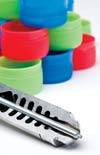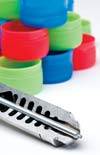Troubleshooting Defects: Part II
Repair technicians should be aware that careful handling of tooling, attention to detail and documentation keeps manifolds functioning properly and prevents costly mistakes.
Hot runner maintenance is tedious work that requires focus, patience and a deft hand when removing and handling tooling, and the discipline to stop and investigate if excessive resistance is felt removing or installing valve pins, heaters, manifolds and related tooling. Knowing what excessive resistance feels like, particularly in hot runner maintenance is an acquired skill that separates an apprentice from a journeyman.
Manifold Maintenance
Referential measurements must be taken periodically during assembly to insure probes, spacers and related tooling are at the correct height and the manifold is resting flat on all probes. Careful handling of tooling and attention to detail is required to keep manifolds functioning properly and without leakage. A minor mistake can be costly.
An improperly seated or torqued probe or manifold, pinched wire, ding or bur can cause the system to leak. Some systems rely on heat expansion to seal, so they must be allowed to soak for 20 to 40 minutes before startup. If shot prematurely, the entire wiring is encapsulated in a plastic cocoon that usually goes undiscovered until heaters begin to short out, or someone notices smoke or plastic oozing from strange places.
Removing this plastic shell is time consuming and expensive, and cleaning methods are limited. Most soften the plastic with a heat gun, and then chip away with a soft (brass or aluminum) chisel and a hammer. You can also send it out to be melted off in an oven, where high temperatures can ruin wires, heaters and thermocouples, and cost you thousands of dollars in labor and replacement parts. For this reason, hot runner maintenance is usually only performed by the most experienced and trusted shop employees.
Keep in mind that every manifold will have its own quirks and procedures or sequence of events that should be documented in the maintenance manual and followed diligently by all repair technicians. The following are instructions for this particular manifold, but will work on many different styles of hot runner manifolds in use today.
Disassembly
- Heat up the probes to 200¼ to soften the plastic and allow the valve pins to be removed easier. With the hot half standing (vertical), use a slide hammer or puller to remove the valve pins and pistons. If using a slide hammer, hold it steady during disassembly, as it is easy to slightly bow the valve pins and leave you wondering how to blame it on process.
- As you remove the valve pins, pistons and any related tooling, verify all are numbered (engraved) correctly to mold position, and if not, do so now.
- Insert the valve pins into a wooden board marked to position and drilled to size to keep them separated, accessible and safe. Shut-off the probe heats when you are finished.
- Probe tips should be covered with sections of rubber hose or tape to safeguard delicate tip configurations.
- Heater wires and thermocouples should be labeled to position before removing any components.
- If you can't unbolt or remove the electric control box from the mold, then it will be necessary to unhook each probe/heater and thermocouple wire individually from the control box connectors. I have seen many instances where wires are cut and spliced back together, but I don't recommend it.
- Lay the mold down on its face (horizontal), on parallels if necessary to protect the probes, with the manifold up and remove the manifold bolts. This position allows for more control during removal of the manifold with an overhead hoist and is easier to see what's going on underneath as you lift it out of the frame. If the probes need to be tapped out along with the manifold, you will have to do this with the plate standing in the vertical position.
- It is usually necessary to use a pry-bar to help persuade the manifold to lift out evenly. Work carefully; most manifolds are located with hardened dowels for exact alignment, which are easily broken if put on a bind. Note: Even if the probes are not bolted directly to the manifold, they will usually stay attached to the manifold since the plastic between them has cooled.
- Carefully raise the manifold out of the frame, watching closely for heater and thermocouple wires that are in the way or restricting removal, and set the system off to the side.
- Once the manifold and probes are out of the mold plates, immerse the nasty, residue-encrusted plates in the sonic tank and let the magic happen while you troubleshoot the long gate issues. We will discuss various cleaning methods in upcoming articles.
Troubleshooting Long Gate Vestige (or Gate Flash)
Review past long gate defects, looking for repetitive positions and what corrective action was taken to insure we don't repeat an ineffective repair. For this example, we will assume that all long gate defects are new to the position. Long gate issues with this type of shut-off (tapered) are usually due to the following 10 probable causes. The first six are mold issues and the last four are process-related issues that should be checked at the press before the mold is pulled for repairs.
1. Worn or hobbed faces of the valve pin or gate shut-off area
Corrective Action
- Examine the fit and condition of the two under a microscope and interchange new tooling with old to determine what area is worn. Sometimes it is necessary to grind or lap the valve pin with 400 grit lapping compound for a tight fit at the gate.
- Verify the valve pin alignment mechanism (usually a bushing) inside the probe is not worn, which will cause premature wear.
2. Worn piston cup o-rings
Corrective Action
- Examine the o-rings, looking for flat or abraded spots. When installing new o-rings, the o-ring groove should be filled with high temperature grease before you install the o-ring, packing the squeeze-out around the outside of the o-ring insuring long life. Replace these type o-rings every 750,000 to 1 million cycles.
3. Excess resin weepage inside piston cup, limiting forward travel of valve pin
Corrective Action
- Make sure all weep channels are open.
- Discuss with process the importance of not letting the mold sit idle in the press at processing temperatures. Keeping plastic moving through the manifold greatly reduces burning that creates excess weepage and off gassing.
- Measure the wear on the body of the valve pin as it relates to the manifold guide bushing. More than 0.001 clearance can let plastic leak past this seal.
4. Air feed lines through plate blocked
Corrective Action
- Clean the lines. Regular immersion in a sonic tank will keep these lines clean.
5. Defective probe heater or thermocouple
Corrective Action
- Perform a continuity check at the amphenol on all heaters with a volt meter and be sure to do a ground fault test on the thermocouples.
- Use a pyrometer to verify probe temperature.
- Hook manifold up to controller and ramp up heater temperatures in 50¼ increments and look for fluctuations in the read-outs.
6. Incorrect valve pin to gate insert stack height
Corrective Action
- Today, some hot runner manufacturers use mathematical formulas to calculate theoretical thermal expansion of valve pins and related tooling and plates. If the correct length of the valve pin is in question as it relates to preload on the insert gate (no preload will cause long gates, too much will fracture the gate), and specific print dimensions are not available or trustworthy, use a more direct method as shown in Figure 1. Valve pin to gate preload usually runs from 0.002 to 0.005 depending upon the resin and how thick (and brittle) the steel is surrounding the tapered shut-off of the gate.
7. Insufficient air pressure at press to close valve pins
Corrective Action
- Use an air pressure gage to verify correct pressure on both sides of the valve controlling valve pin actuation. Tapered valve pin shut-offs require at least 100 psi of line pressure.
8. Insufficient cooling (water) on gate inserts
Corrective Action
- Verify water channels are open and clean.
- Verify correct water temperature, flow and that an excessive amount of jumpers are not being used at the press.
9. Incorrect process parameters
Corrective Action
- Verify parameters and compare to past settings.
10. Incorrect timing of valve pin closing
Corrective Action
Valve pin closing is usually actuated by the injection hold or pack time. This can sometimes be verified visually at the press by dry cycling the mold.
Related Content
How to Eliminate Chatter
Here are techniques commonly used to combat chatter and guidelines to establish a foundation for optimizing the moldmaking process.
Read MoreRevisiting Some Hot Runner Fundamentals
What exactly does a hot runner do? If you’ve been in the injection molding industry for any length of time, you might think the answer is obvious, but it is not.
Read MoreIt Starts With the Part: A Plastic Part Checklist Ensures Good Mold Design
All successful mold build projects start with examining the part to be molded to ensure it is moldable and will meet the customers' production objectives.
Read MoreMaintaining a Wire EDM Machine
To achieve the ultimate capability and level of productivity from your wire EDM on a consistent, repeatable and reliable basis, regular maintenance is a required task.
Read MoreRead Next
Trends in Hot Runner Technology
Quality, performance, maintenance and flexibility are driving today’s hot runner technology.
Read MoreReasons to Use Fiber Lasers for Mold Cleaning
Fiber lasers offer a simplicity, speed, control and portability, minimizing mold cleaning risks.
Read MoreHow to Use Continuing Education to Remain Competitive in Moldmaking
Continued training helps moldmakers make tooling decisions and properly use the latest cutting tool to efficiently machine high-quality molds.
Read More




















